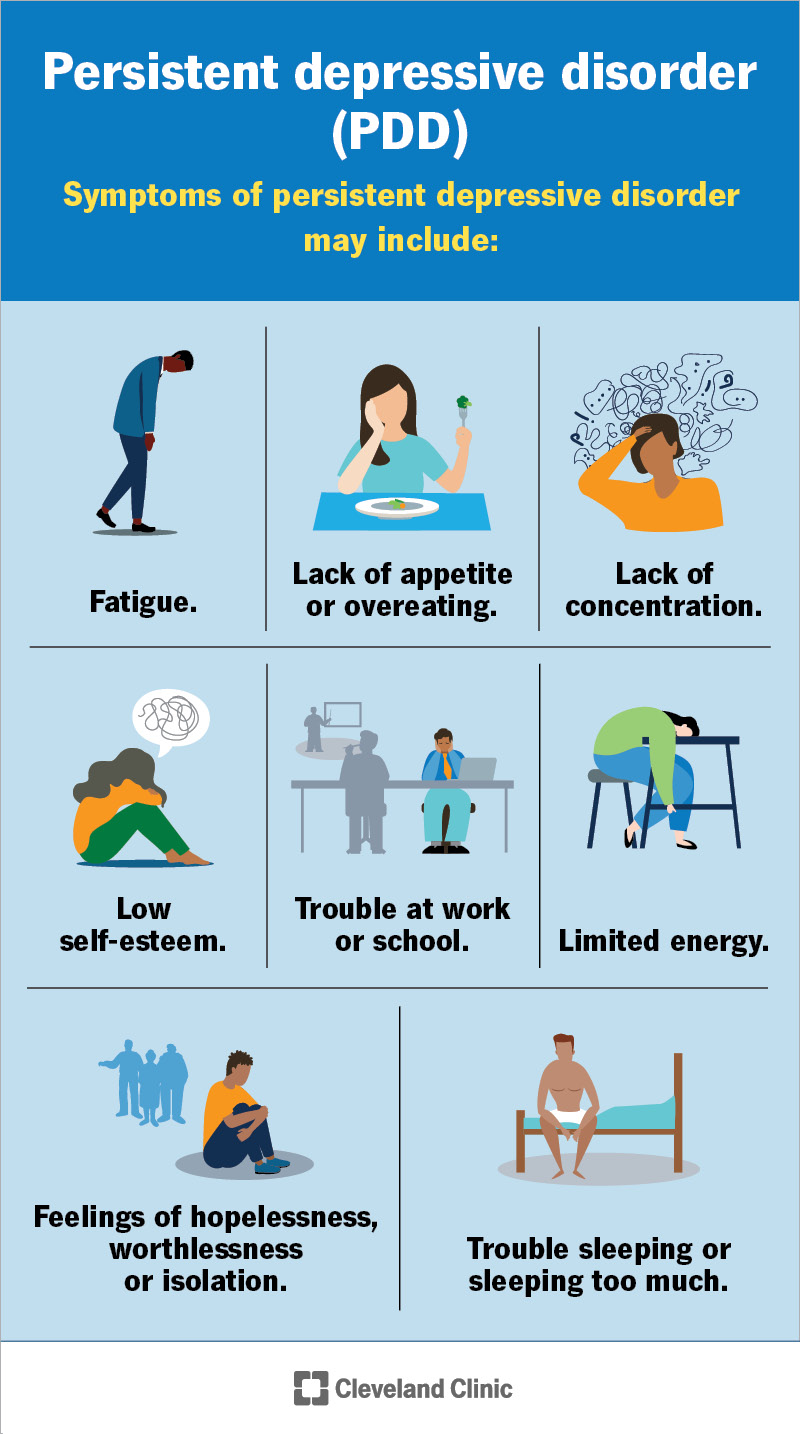Persistent depressive disorder (PDD) is a mild to moderate chronic depression. It involves a sad or dark mood most of the day, on most days, for two years or more. PDD is common and can happen to anyone at any age. The most effective treatment combines medication, counseling and healthy lifestyle choices.
Advertisement
Cleveland Clinic is a non-profit academic medical center. Advertising on our site helps support our mission. We do not endorse non-Cleveland Clinic products or services. Policy
Persistent depressive disorder (PDD), formerly known as dysthymia or dysthymic disorder, is mild or moderate depression that doesn’t go away. If you have persistent depressive disorder, you may experience low mood, as well as other symptoms, occurring most days without going away.
Advertisement
Cleveland Clinic is a non-profit academic medical center. Advertising on our site helps support our mission. We do not endorse non-Cleveland Clinic products or services. Policy
Researchers estimate that 1.5% of U.S. adults had persistent depressive disorder in the past year. They estimate that 2.5% of U.S. adults have experienced persistent depressive disorder at some time in their lives.

The main symptom of persistent depressive disorder is a sad, low or dark mood. Other persistent depressive disorder symptoms may include:
Scientists don’t fully understand what causes persistent depressive disorder. Most likely, depression is caused by abnormal connections between different parts of your brain, preventing your brain cells from communicating with each other as they should.
Persistent depressive disorder affects women more often. The condition also tends to run in biological families. So, if you have a biological family member with persistent depressive disorder, you may be more likely to develop it.
If you think you have persistent depressive disorder, talk to a healthcare provider. There aren’t any tests for chronic depression, so the diagnosis comes from discussions with your provider. Your provider also might refer you to a psychologist or psychiatrist for further evaluation.
Advertisement
The most effective persistent depressive disorder treatment combines medications and talk therapy, or counseling.
Antidepressants are prescription drugs that can relieve depression. There are many different kinds of medications for the treatment of depression. You may need to take medication for a month or longer before you feel a difference. Make sure to continue taking the medication exactly as your healthcare provider prescribes. If you have side effects, let your healthcare provider know.
Counseling can also help manage persistent depressive disorder. One type of therapy, cognitive behavioral therapy (CBT), is often helpful for depression. A therapist or psychologist will help you examine your thoughts and emotions and how they affect your actions. CBT can help you unlearn negative thoughts and develop more positive thinking.
With medication, talk therapy and lifestyle changes, you can manage persistent depressive disorder and feel better.
But if your symptoms come back or don’t improve, talk to your healthcare provider.
Although you can’t prevent depression, you can take steps to help reduce your risk of developing it. These things may also help improve your symptoms if you’ve already been diagnosed:
If you think about hurting yourself or someone else, tell somebody right away. You can tell a healthcare provider, a friend or a family member.
You can also contact the Suicide and Crisis Lifeline at 988. You’re not alone, and there’s always somebody who wants to help.
Questions you may want to ask your provider include:
If you’re feeling sad or down most of the day, for most days, over a long period of time, you may have persistent depressive disorder (PPD). It’s important to talk to a healthcare provider if you have depressive symptoms. Medication, counseling and healthy lifestyle choices can help make you feel better. If you feel like you might hurt yourself or someone else, seek help immediately — and remember: You’re not alone.
Advertisement
Depression can hamper every aspect of your life. Cleveland Clinic experts are here to help manage your mental health so you can do the things you want.

Last reviewed on 09/28/2024.
Learn more about the Health Library and our editorial process.